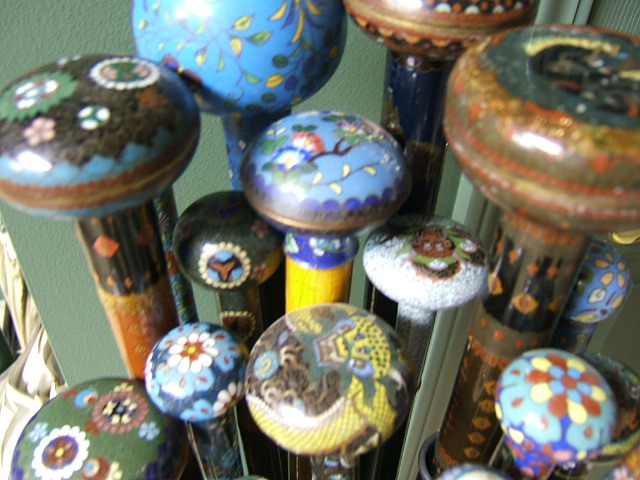 How To Tell The Difference Between Japanese And Chinese Cloisonne (9205) How To Tell The Difference Between Japanese And Chinese Cloisonne (9205)
I see a lot of mislabeling of the origin of cloisonne canes. I'd like to try, once and for all, to make it clear which country they are made in. It's not easy because there aren't hard and fast rules as to what different countries did that make them unique to them. Cloisonne is a French word that means wire cells and goes back 100's of years. All the cloisonne canes I see are from the victorian period of 1840 to Art Deco of 1940. After 1930 they were usually on umbrellas, but you see very few of them on umbrellas, because they are worth more on a shaft, so the umbrellas disapear.
A copper or brass handle has a pattern of wires soldiered to them. Powdered glass is put one color at a time into the cells these wires created and they are put into a kiln for heating. Successive firings complete the enameling process. The surface is then polished, with the entire process taking days. The French were very good at it, but their labor was too expensive compared to China and Japan so the orientals became masters of this art form producing them prolificly. The problem is, when they are dropped, they damage easily, causing most of them to be disposed of. There is more Chinese cloisonne than Japanese, therefore making the Japanese more valuable. It's no wonder as the country is so much larger and has so many more people. Putting handles aside, most cloisonne collectors only collect Japanese.
First the general rules, if there are scrolls or wire designs in a solid background, its usually Chinese. I call these wires that don't hold other colors inside the cell squigals. If it has a solid background it's more commonly Japanese. However, you will see exceptions to even that rule. As a general rule the Japanese quality is also better. In the canes that follow you will see my 2 favorates, a collection of snuff containers with cloisonne shafts, Chinese examples, then Japanese.
Category: Manufactured
Sub Category: Enamel
Listed: 2007-06-20 15:12:53
|










 Online Video
Online Video



